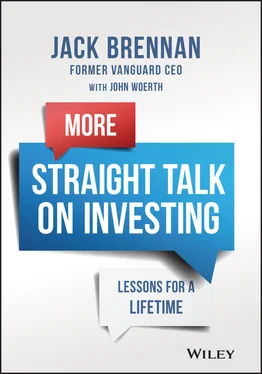232 232
233 233
234 234
235 235
236 236
237 237
238 238
239 239
240 240
241 241
242 242
243 243
244 244
245 245
246 246
247 247
248 249
249 250
250 251
251 252
252 253
253 254
254 255
255 256
256 257
257 259
258 260
259 261
260 262
261 263
262 264
263 265
264 266
265 267
266 269
267 270
268 271
269 272
270 273
271 274
272 275
273 276
274 277
275 278
276 279
277 281
278 282
279 283
280 284
281 285
282 286
283 287
284 288
285 289
286 290
287 291
288 292
289 293
290 294
291 295
292 296
293 297
294 298
295 299
296 300
297 301
298 302
299 303
300 304
301 305
302 307
303 308
304 309
305 310
306 311
307 312
308 313
309 314
310 315
311 316
312 317
313 318
314 319
MORE STRAIGHT TALK ON INVESTING
LESSONS FOR A LIFETIME
JACK BRENNAN
with John Woerth

Copyright © 2021 by John J. Brennan. All rights reserved.
Published by John Wiley & Sons, Inc., Hoboken, New Jersey.
Published simultaneously in Canada.
No part of this publication may be reproduced, stored in a retrieval system, or transmitted in any form or by any means, electronic, mechanical, photocopying, recording, scanning, or otherwise, except as permitted under Section 107 or 108 of the 1976 United States Copyright Act, without either the prior written permission of the Publisher, or authorization through payment of the appropriate per-copy fee to the Copyright Clearance Center, Inc., 222 Rosewood Drive, Danvers, MA 01923, (978) 750-8400, fax (978) 750-4470, or on the web at www.copyright.com. Requests to the Publisher for permission should be addressed to the Permissions Department, John Wiley & Sons, Inc., 111 River Street, Hoboken, NJ 07030, (201) 748-6011, fax (201) 748-6008, or online at http://www.wiley.com/go/permission.
Limit of Liability/Disclaimer of Warranty: While the publisher and author have used their best efforts in preparing this book, they make no representations or warranties with respect to the accuracy or completeness of the contents of this book and specifically disclaim any implied warranties of merchantability or fitness for a particular purpose. No warranty may be created or extended by sales representatives or written sales materials. The advice and strategies contained herein may not be suitable for your situation. You should consult with a professional where appropriate. Neither the publisher nor author shall be liable for any loss of profit or any other commercial damages, including but not limited to special, incidental, consequential, or other damages.
For general information on our other products and services or for technical support, please contact our Customer Care Department within the United States at (800) 762-2974, outside the United States at (317) 572-3993 or fax (317) 572-4002.
Wiley also publishes its books in a variety of electronic formats. Some content that appears in print may not be available in electronic formats. For more information about Wiley products, visit our web site at www.wiley.com.
Library of Congress Cataloging-in-Publication Data is Available:
ISBN 9781119817338 (Hardcover)
ISBN 9781119817352 (ePDF)
ISBN 9781119817345 (ePub)
Cover Design: C. Wallace
Cover Image: Paper Speech Bubble © iStock.com/Aquir
To my growing and loving family. Once we were 5 and now we are 11, with another on the way!
and
To the millions of Vanguard investors, thousands of crew members, and hundreds of investment professionals who have inspired me and taught me for four decades.
In July 2002, I began the preface for the first edition of Straight Talk on Investing by observing that the previous “five years have been extraordinary in the history of investing. A record bull market swelled into one of the largest speculative bubbles in history. Then we saw the bursting of that bubble and the onset of a prolonged bear market, the worst one that the U.S. stock market has experienced since World War II. If many investors seem shaken and unsure of what to do, no wonder. Within half of a decade, we have been presented with a lifetime's worth of lessons about investing.”
It is with a dose of cruel irony as I sit down to write the preface for the second edition in late 2020. The world at large is struggling with the coronavirus pandemic, which initially brought on a swift and severe drop in the global stock markets. While the markets quickly recovered, this marked the third shock experienced by investors in the first 20 years of the twenty-first century. Given this backdrop, it is no wonder investing can appear to be so daunting.
Albert Einstein once said, “The only source of knowledge is experience.” Maintaining a long-term perspective and controlling one's emotions are valuable lessons that investors can glean from trying times. However, the impetus for updating this book with a second edition goes beyond the teachings of these distinct market events. While the financial planning and investing principles covered in these pages are timeless, a considerable amount has changed in the nearly 20 years since the first edition. I've learned a bit more along the way, including framing investing as a series of trade-offs—a theme that I will weave into this latest version.
At the outset, a new generation of investors has come of age and could benefit from understanding that sensible investing is an effective way to achieve financial security. I will note, too, studies indicate that members of the Millennial Generation—one of the audiences for the initial book—are far more wary of the stock market than Baby Boomers. Their wariness is understandable, having seen their parents withstand the bear market of 2000–2002, or experiencing 2008–2009 and 2020 themselves. But participating in the market is a must for long-term financial security, and for this generation now in the prime of their investing years, as well as for Generations Z and Y, a primer may be helpful.
I also underscore the concept of thinking of yourself as a financial entrepreneur —managing your financial life as an owner manages his or her business. And it is your financial life and no one else's, which is saying that financial planning and investing are highly, highly personal. While your age and goals may be similar to those of a friend, colleague, or neighbor, your investment program may be vastly different based on your ability to withstand risk, your means, and your time horizon, among many other factors.
The investing landscape has also changed considerably, and changed for the better in terms of choice, cost, and convenience. I genuinely believe that there has been no better time to be an investor.
Perhaps most obviously, the costs of investing have declined dramatically. Commissions or front-end loads, once as high as 8-1/2% on mutual fund purchases, have virtually disappeared. The average asset-weighted expense ratio of stock funds has dropped nearly by half, from 0.99% in 2000 to 0.52% in 2019—roughly $100 on a $10,000 investment to around $50, according to the Investment Company Institute. Costs, risk, and reward are the three critical factors when considering any investment. But only cost is actually known in advance and, all things equal, lower costs will result in higher returns for investors. As you can see from the cost figures cited here, investors today have a strong relative tailwind compared to only a short two decades ago.
Читать дальше













